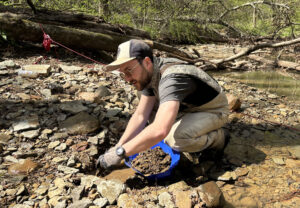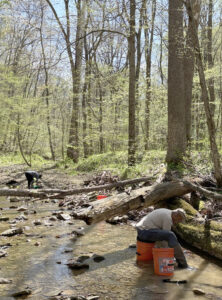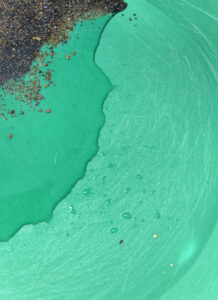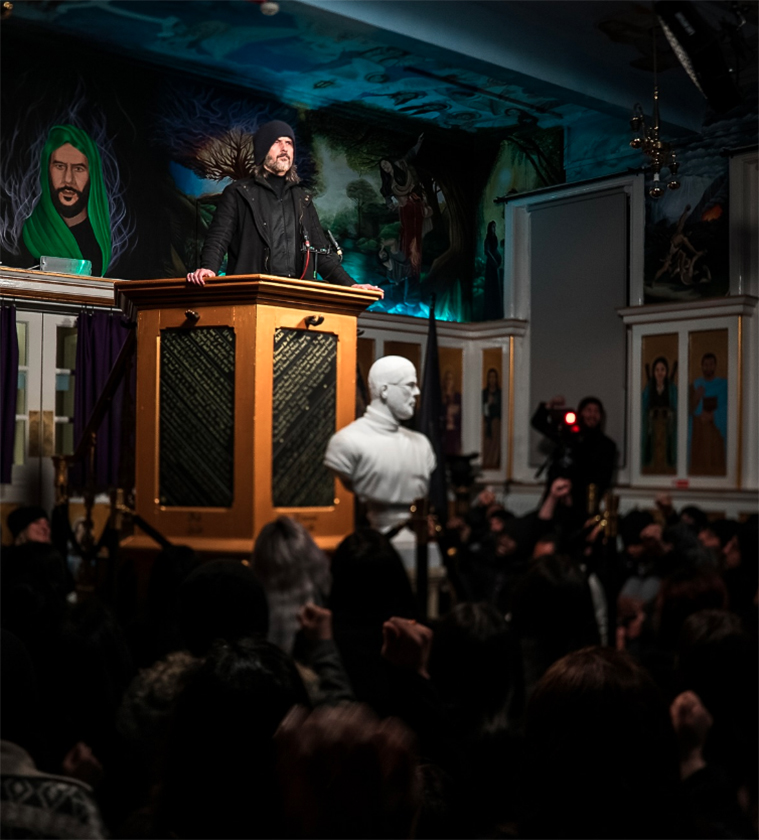
MORGAN-MONROE STATE FOREST — When gold was discovered in California in the late 1840s, hundreds of thousands of people came west to strike it rich. The event was, in many ways, one of humanity’s low points. The journey itself claimed many lives, and the settlers who survived would often commit heinous crimes and acts of treachery, propelled by the greed of “gold fever.”
All this took place in the name of getting rich quick — something very few people actually accomplished.
At time of writing, the price of gold per ounce is $3,335.40. If you were to pan enough gold to fill a typical 16.9 ounce bottle of Coca-Cola, you would have more than $56,000, which is higher than the median yearly income in the U.S.
You won’t, of course, find that much gold in Morgan-Monroe State Forest.
“If you work hard, and you’re here all day, you’ll probably find close to half a gram,” said Indiana Gold Prospectors (IGP) Director Thomas Fowlkes. “That’s about $50.”
Members of the IGP visited the Morgan County side of the forest April 27 to try their hand at finding themselves a few bucks, one of many outings the group takes throughout the state during the spring and fall, peak gold panning seasons.
Indiana’s gold comes from the ancient glaciers that drifted down from Canada, and there are a lot of gold panning enthusiasts throughout the state as a result.
But if the gold prospectors would make more money working shifts at the local McDonald’s, why do they even bother looking for gold?
Angie Andrews, an IGP member and Johnson County resident, has been gold panning for the past three years, and she’s never had any illusions about striking it rich in Indiana.
“I would never even sell the gold I’ve found,” Andrews said. “I wouldn’t even know where to go to sell it.”

The gold diggers
Everyone has their reasons.
Neal Bauma, a Morgantown resident involved with the IGP, has been gold panning since 2015 after a friend got him into it. Bauma fell so much in love with the hobby that he now makes a lot of his own gold panning tools, customizing them to his needs. He keeps the gold he finds in little jars, never imagining that he would give it away.
“I was born in ’71,” Bauma said. “I grew up watching those cowboy shows on television. When I go out looking for gold, I feel like I’m living that life. And one of these days, I’m gonna find a really good spot.”
As for Andrews, her gold fever began with a sleepless night a few years ago. She lay awake in bed and started going down internet rabbit holes, eventually learning there was gold to be found in Indiana — and there are some places, allegedly, where you might even find a lot. She hasn’t found any of the “really good spots,” as Bauma says, but mostly, she likes the community of gold panners and a reason to spend some time in nature.
Bauma owns his own body shop. Andrews teaches children to read. Fowlkes, the director, is a retired soldier, having served in the Army for 30 years.
Dillon Bowman, a self-described “G-Man” who works for the Department of Defense, was the last to arrive for the April 27 outing. He joined his fellow IGP members in the forest with his Australian shepherd, Sundance, and casually but confidently said if The Correspondent wanted a story, he had a story.
“I’m looking for enough gold for an engagement ring,” Bowman said. “I’ve spent more money on mining crap than I would have on the ring,” he adds with a smile.
Bowman has been with his girlfriend, Rea, for three years. She’s a doctor, so he wants to make sure the ring he makes for her won’t interfere too much with the rubber gloves she often wears. He wants to find 10 grams of gold for the ring — after nine months of gold hunting, he’s found about three grams so far.
The Correspondent got Bowman’s assurance that publishing his plan wouldn’t spoil any surprises. Rea apparently knows all about it, underscoring a key to any good marriage — patience.

Deadman Hollow
The four of us take a ride down the gravelly hills to Deadman Hollow, kicking up dirt clouds the whole way there. It’s a sunny day, and when the engines are off the only sounds in the air are the breeze and the birds overhead.
Andrews, big backpack over her shoulders, leads the way down the grassy trail, ducking under branches and stepping over mud as she goes. Inside the backpack, she carries a shovel, pans, a classifier, a foldable stool, a pair of boots and something she has no better name for than “sucker bottle,” which may just be the most important item of the bunch.
That is where the treasure will go once she finds it.
Eventually we come to a clearing in the forest, a shallow creek bed before us, and we make our stop. Andrews drops her backpack on the shore and retrieves her boots and the plastic green pan all the prospectors use on their expeditions.
On the bottom of the pan is an apt Proverb: “With me are riches and honor, enduring wealth and prosperity.”
Andrews steps into the water, and scans for the best place to strike. When she chooses a spot, she lays the pan down into the water and places the colander-like classifier over the top of it. She then takes her hand shovel and buries it into the creek, pulling up a combination of water, mud and rocks that she dumps into the classifier.
Before long, Andrews sets aside the classifier and lifts the pan. The plan now is to slowly pour out the water and rocks to see what lies at the bottom of the pan. She pours fairly liberally, not worrying much about going too fast. What she’s after is unlikely to fall out — it’ll be the heaviest thing in the pan.
Finally, most of the water is back in the creek and what’s left in the pan is mostly pitch black soil and pebbles. But Andrews looks a little closer, tilting the pan toward the sunlight. Her eyes light up when she sees it.
There, glittering up at her from the bottom of the pan, are a few specks of the treasure she was hoping to find.








